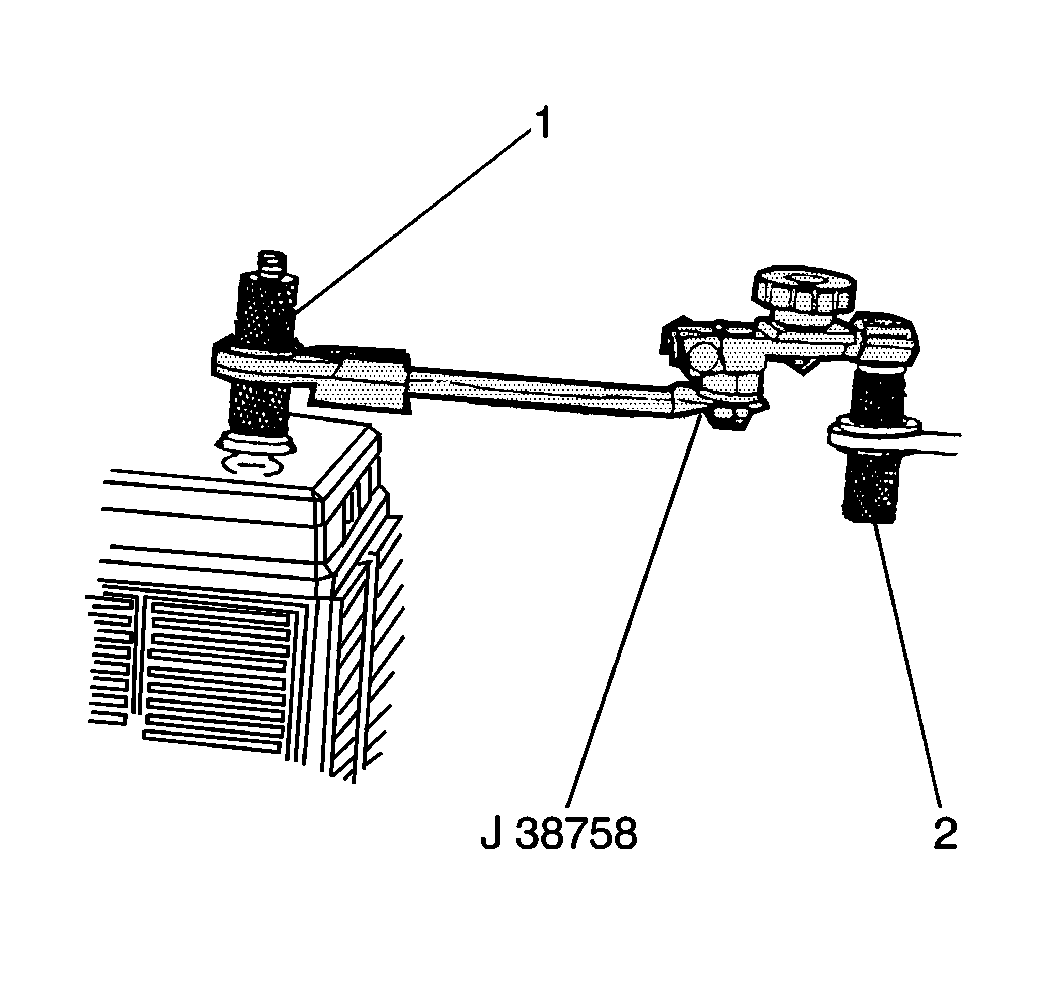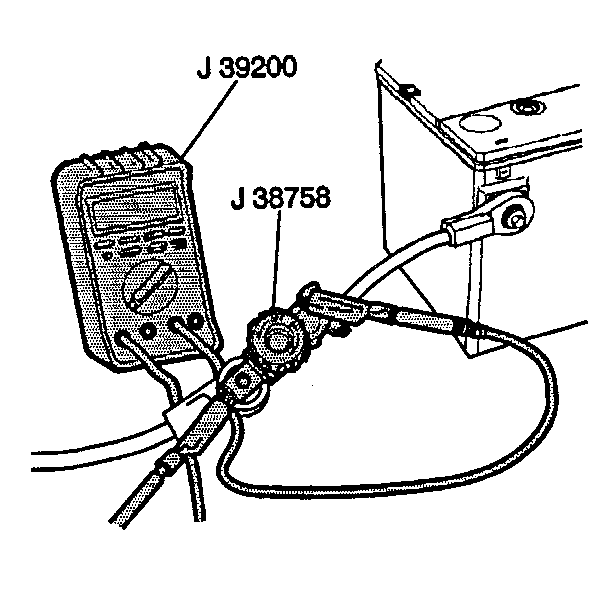Battery Electrical Drain/Parasitic Load Battery Electrical Drain
Inspect the electrical system for excessive electrical
drain (parasitic current drain) if the vehicle battery meets one of the following
conditions:
| • | The battery is low or dead after an overnight period. |
| • | The battery discharges over a period of 2-3 days. |
Inspect the vehicle for excessive parasitic current drain if a battery
needs recharging and no obvious cause exists.
Failure of one or more of the on-board solid state control modules,
such as the PCM, may cause a high parasitic drain on the vehicle's battery.
After the circuit continuity is restored, disconnecting the battery in order
to install an ammeter or in order to test for excessive current drain may
not continue. Cycling the engine control switch to the ON position and then
to the LOCK position may cause such a drain to recur. Unless the vehicle's
systems are reactivated in a road test, some drains will not recur.
Do not rotate the engine control switch to the following positions with
an ammeter installed between the battery terminal and the battery cable:
Use a current drain test tool in order to test the battery for parasitic
current drain. Refer to
Battery Electrical Drain/Parasitic Load
.
Battery Electrical Drain/Parasitic Load Current Drain Test
Tools Required
| • | J 38758 Parasitic
Draw Test Switch |
Perform the following procedure before starting the battery electrical
drain/parasitic load test:
- Turn the engine control switch to the LOCK position.
- Turn off all electrical accessories.
- Close the vehicle's doors.
Notice: J 38758 should never be turned to the OFF position, with the engine
running or damage could occur to the vehicle's electrical system.
Caution: Unless directed otherwise, the ignition and start switch must be in the OFF or LOCK position, and all electrical loads must be OFF before servicing
any electrical component. Disconnect the negative battery cable to prevent an electrical spark should a tool or equipment come in contact with an exposed electrical terminal. Failure to follow these precautions may result in personal injury and/or damage to
the vehicle or its components.
- Remove the
negative battery cable at the main battery. Refer to Negative Battery Cable
in
Battery Cable Replacement
.
The main battery will be wired from the positive battery terminal to
the starter motor.

- Use the following procedure
in order to install the male end of J 38758
to the negative battery terminal:
| 2.1. | Remove the terminal bolt from the battery cable end of the test
switch. |
| | Important: Ensure that the bottom of the adapter firmly contacts the pad or base
of the battery post.
|
| 2.2. | Thread a terminal adapter (1) onto the negative terminal post
of the battery. |
| 2.3. | Place the battery cable end of J 38758
over the threaded end of the terminal adapter. |
| 2.4. | Thread a second terminal adapter over the first terminal adapter. |
| 2.5. | Turn the knob of the J 38758
to the OFF position. |
| 2.6. | Use a set of terminal adapters in order to install the negative
battery cable to the female end of the J 38758
. |
- Turn the knob on the J 38758
to the OFF position.
- Install the negative battery cable to the female end of J 38758
.
- Turn the test switch to the ON position.
- Road test the vehicle and activate all accessories including the
radio and air conditioning.
- Turn the ignition switch to the OFF position and remove the key.

Important: Electrical continuity in the ground circuit to the battery must be maintained
from this point forward. Use the J 38758
(in the ON position) or the ammeter in order to maintain electrical
continuity.
- Some components, including PCMs, have timers that draw several amps
of current when the components cycle down. This condition may cause an incorrect
parasitic current drain reading. Wait 15 minutes in order to allow
the above components to power down before continuing the test.
Important: If using a digital multimeter other than the J 39200
, ensure that the vehicle does not have excessive current drain.
Excessive current drain may damage the multimeter when the multimeter is
installed.
- Use the following procedure in order to test the current drain level:
| 9.1. | Connect a jumper wire with an in-line 10 amp fuse to the J 38758
terminals. |
| 9.2. | Turn the J 38758
to the OFF position. |
| 9.4. | Inspect for a blown fuse. |
If the fuse does not blow, the current draw is less than 10 amps
and the J 39200
may operate
safely.
| 9.5. | Turn the J 38758
to the ON position. |
Turning the J 38758
to the ON position before installing the J 39200
maintains continuity in the electrical system.
| 9.6. | Remove the fused jumper wire. |
- Set the J 39200
to the 10 amp scale and connect the multimeter to theJ 38758
.
- Turn the J 38758
to the OFF position. Current now flows through theJ 39200
only.
- Wait at least 60 seconds in order to observe the current
reading.
If the current reading is at or below 2 amps, turn the test switch
to the ON position (in order to maintain continuity in the electrical system)
and switch the J 39200
to the 2 amp scale for a more accurate reading.
- Turn the J 38758
to the ON position.
- Measure the reading in milliamps, if necessary.
- Refer to Battery Specifications in
Battery Usage
in order to determine the reserve capacity of the battery.
- Divide the reserve capacity value by 4 and compare the result
to the J 39200
reading.
The current drain reading should not exceed the value determined above.
Example: If a battery has a reserve capacity of 100 minutes, the current
drain should not exceed 25 milliamps.
NOTICE: Always turn the test switch knob to the ON position before removing
each fuse in order to maintain continuity in the electrical system and to
avoid damaging the digital multimeter due to accidental overloading, such
as opening a door to change a fuse.
- If the current draw is excessive, remove the system fuses one at a time
until the draw returns to a value less than or equal to the specified value.
In order to protect the J 39200
without disrupting electrical continuity, turn the test switch
to the ON position before opening the door.
- Start with fuses that are hot at all times. Refer to Fuse Block
Details Schematics in Wiring Systems.
- Remove the courtesy lamp fuse and observe the J 39200
reading.
- If the parasitic load remains excessive perform the following
steps:
| 20.1. | Removing the other fuses, one at a time. |
| 20.2. | Leave the courtesy lamp fuse out during diagnosis so the vehicle
door can be left open. |
| 20.3. | Observe theJ 39200
reading each time a fuse is removed. |
- The PCM fuse should cause a drop of less than 10 milliamps
when removed.
- If the drop is more than 10 milliamps, inspect the PCM
wiring for a short to ground. Also, inspect the components connected to the
wires. Refer to the related schematics for the system being worked on.
- Repeat the parasitic current drain test after the condition has
been located and repaired. The vehicle could have more than one parasitic
current drain.
- When the cause of the excessive current draw has been located
and repaired, remove the J 39200
, the J 38758
and
the terminal adapters.
- Reconnect the negative battery cable.


